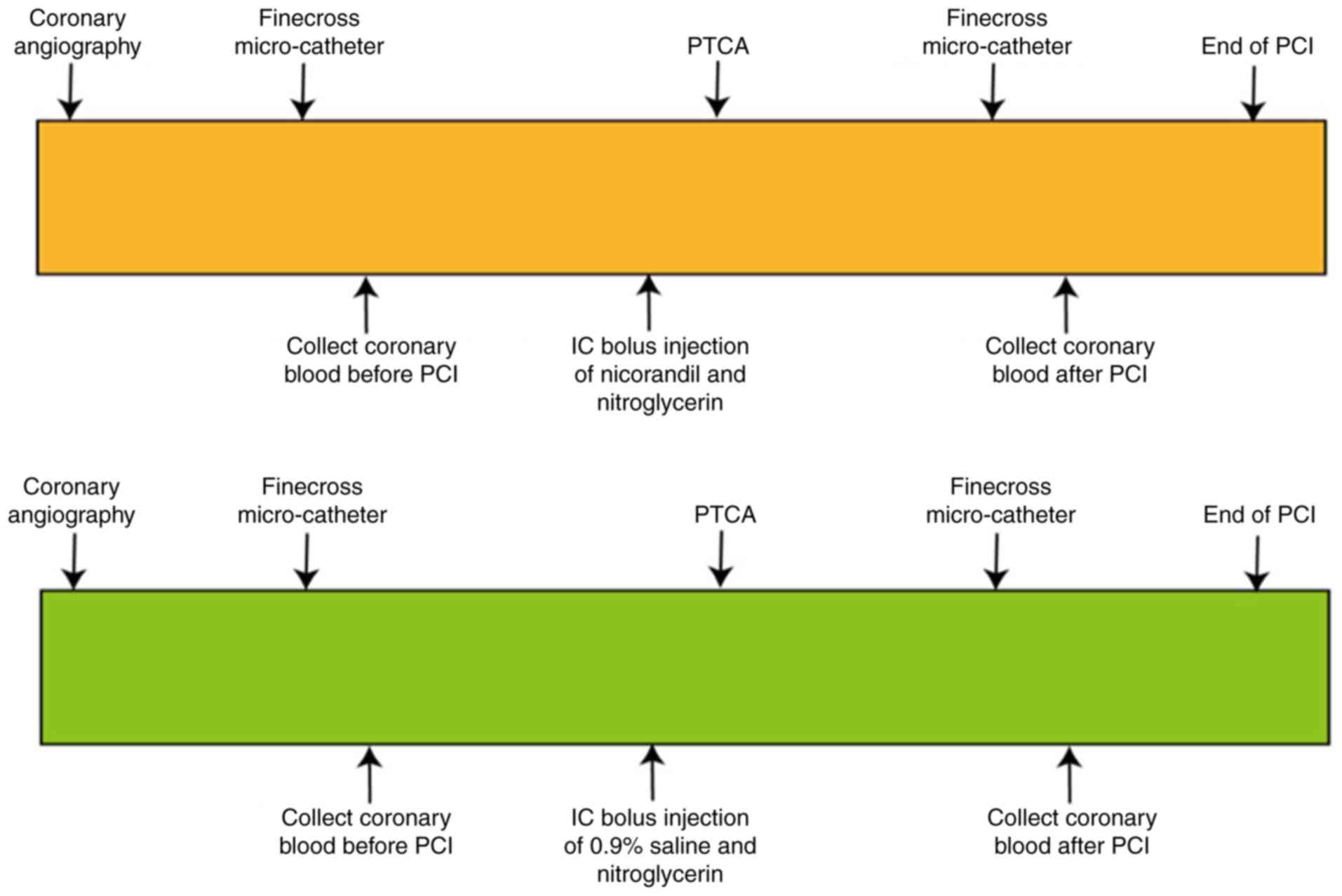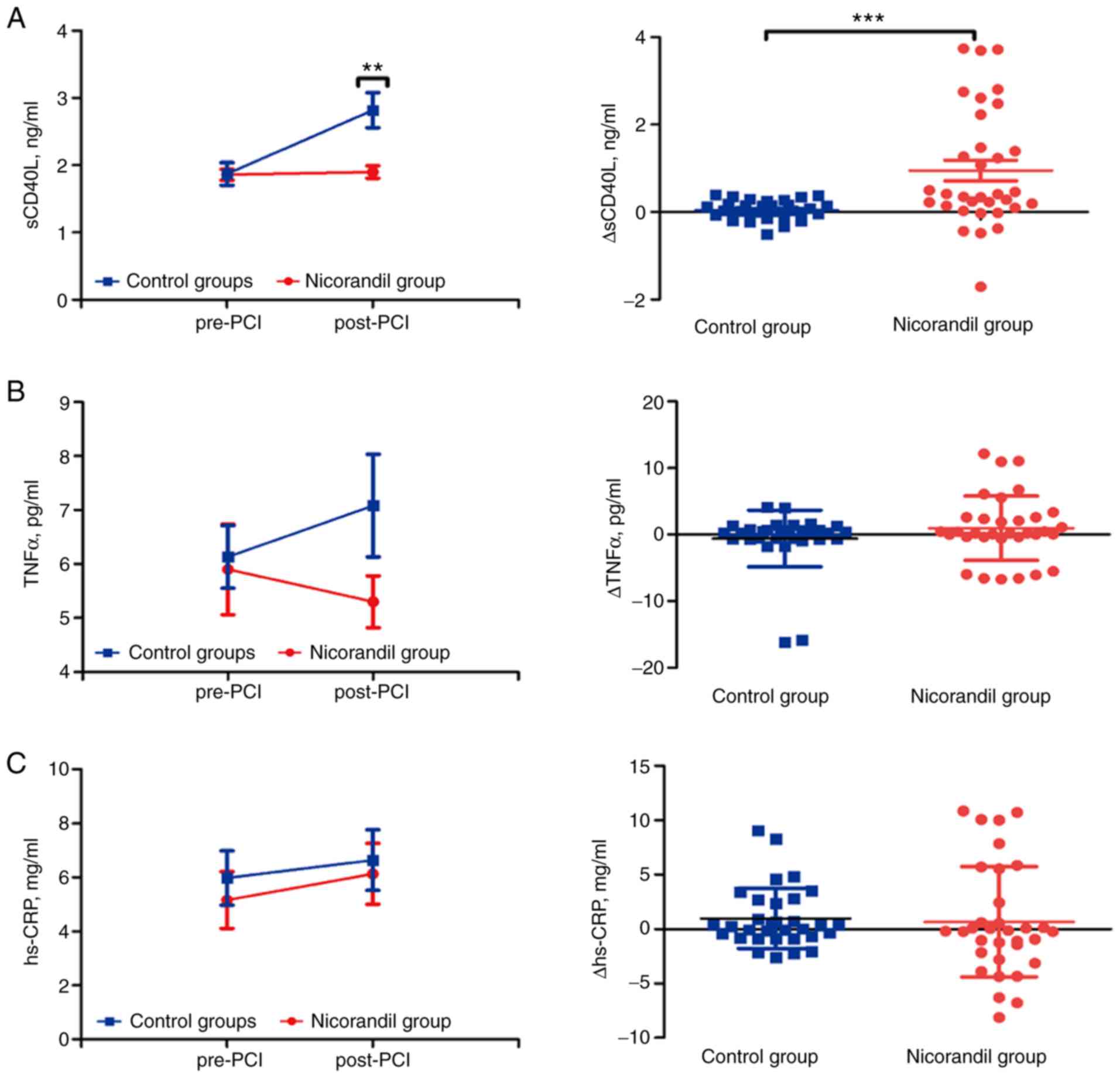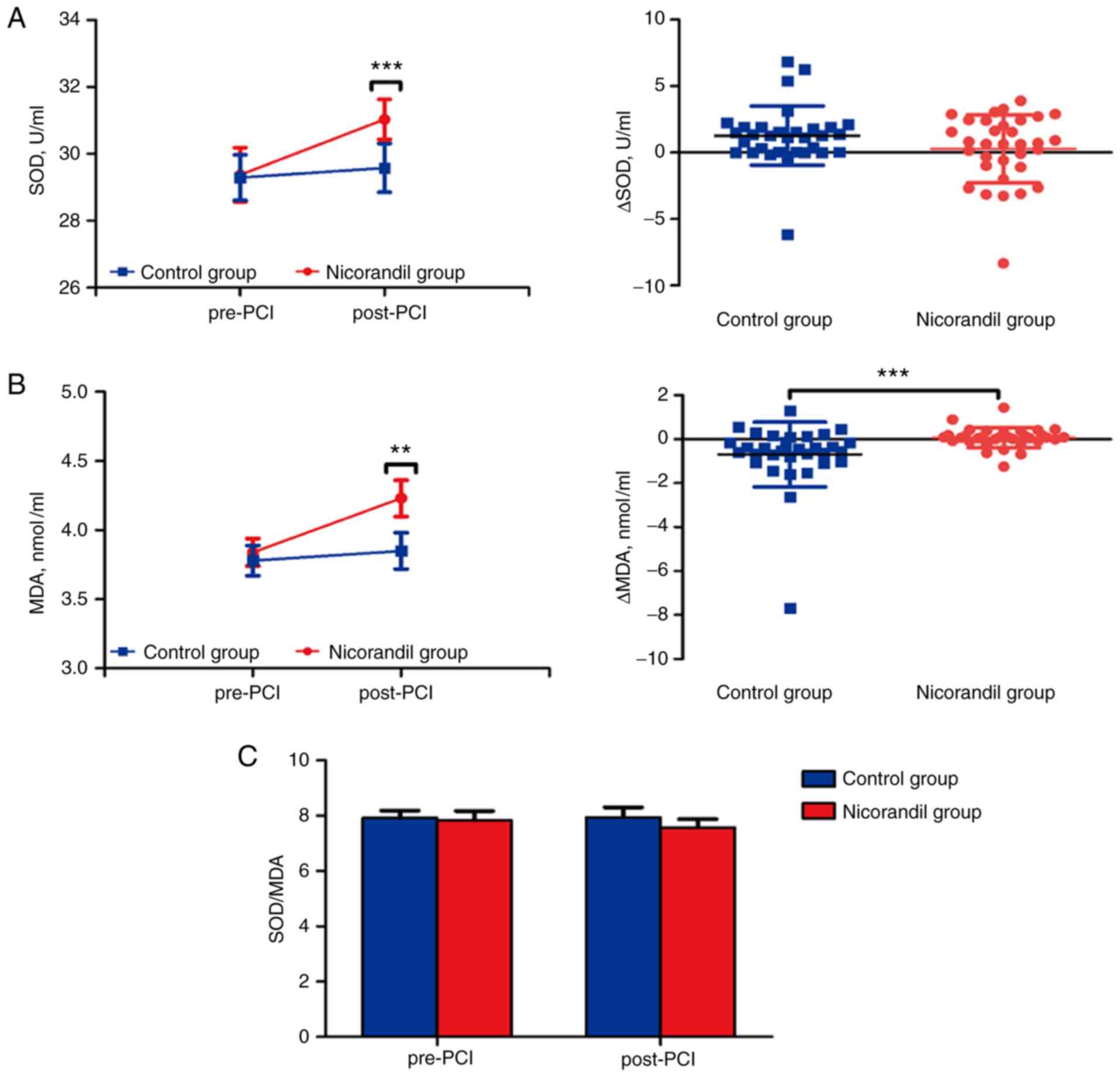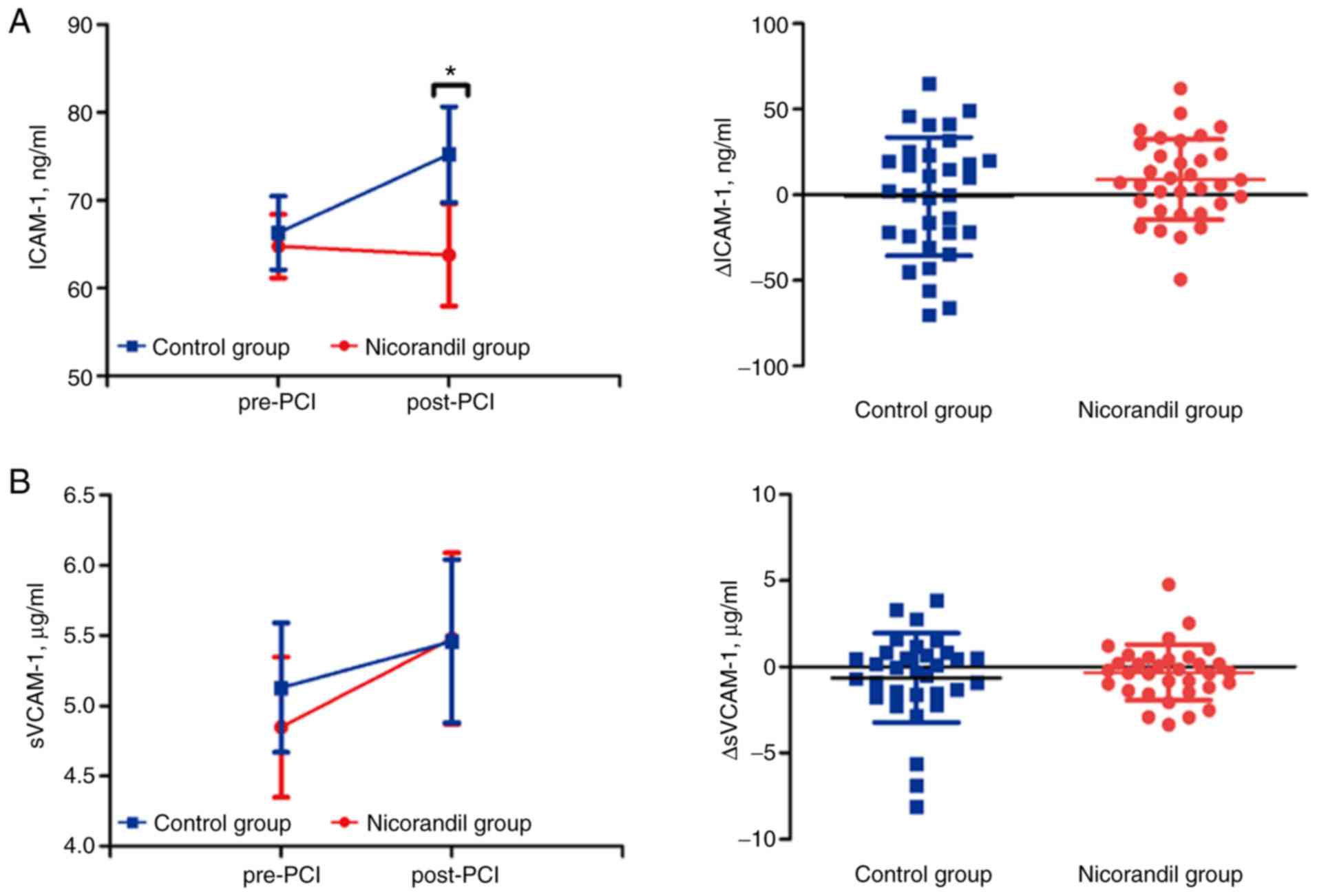|
1
|
Ajtay Z, Németh A, Sulyok E, Cziráki A,
Szabados S, Martens-Lobenhoffer J, Awiszus F, Szabó C and
Bode-Böger SM: Effects of stent implementation on plasma levels of
asymmetric dimethylarginine in patients with or without ST-segment
elevation acute myocardial infarction. Int J Mol Med. 25:617–624.
2010.PubMed/NCBI
|
|
2
|
Kochiadakis GE, Arfanakis DA, Marketou ME,
Skalidis EI, Igoumenidis NE, Nikitovic D, Giaouzaki A, Chlouverakis
G and Vardas PE: Oxidative stress changes after stent implantation:
A randomized comparative study of sirolimus-eluting and bare metal
stents. Int J Cardiol. 142:33–37. 2010. View Article : Google Scholar : PubMed/NCBI
|
|
3
|
O'Donoghue ML, Morrow DA, Cannon CP,
Jarolim P, Desai NR, Sherwood MW, Murphy SA, Gerszten RE and
Sabatine MS: Multimarker risk stratification in patients with acute
myocardial infarction. J Am Heart Assoc. 5(pii):
e0025862016.PubMed/NCBI
|
|
4
|
Mcclelland RL, Jorgensen NW, Budoff M,
Blaha MJ, Post WS, Kronmal RA, Bild DE, Shea S, Liu K, Watson KE,
et al: 10-year coronary heart disease risk prediction using
coronary artery calcium and traditional risk factors: Derivation in
the MESA (Multi-Ethnic Study of Atherosclerosis) with validation in
the HNR (Heinz Nixdorf Recall) study and the DHS (Dallas Heart
Study). J Am Coll Cardiol. 66:1643–1653. 2015. View Article : Google Scholar : PubMed/NCBI
|
|
5
|
Liuzzo G, Buffon A, Biasucci LM, Gallimore
JR, Caligiuri G, Vitelli A, Altamura S, Ciliberto G, Rebuzzi AG,
Crea F, et al: Enhanced inflammatory response to coronary
angioplasty in patients with severe unstable angina. Circulation.
98:2370–2376. 1998. View Article : Google Scholar : PubMed/NCBI
|
|
6
|
Kubica J, Kozinski M, Krzewina-Kowalska A,
Zbikowska-Gotz M, Dymek G, Sukiennik A, Piasecki R, Bogdan M,
Grzesk G, Chojnicki M, et al: Combined periprocedural evaluation of
CRP and TNF-alpha enhances the prediction of clinical restenosis
and major adverse cardiac events in patients undergoing
percutaneous coronary interventions. Int J Mol Med. 16:173–180.
2005.PubMed/NCBI
|
|
7
|
Buffon A, Liuzzo G, Biasucci LM,
Pasqualetti P, Ramazzotti V, Rebuzzi AG, Crea F and Maseri A:
Preprocedural serum levels of C-reactive protein predict early
complications and late restenosis after coronary angioplasty. J Am
Coll Cardiol. 34:1512–1521. 1999. View Article : Google Scholar : PubMed/NCBI
|
|
8
|
Ikeda U, Ito T and Shimada K:
Interleukin-6 and acute coronary syndrome. Clin Cardiol.
24:701–704. 2010. View Article : Google Scholar
|
|
9
|
Liuzzo G, Biasucci LM, Gallimore JR,
Grillo RL, Rebuzzi AG, Pepys MB and Maseri A: The prognostic value
of c-reactive protein and serum amyloid a protein in severe
unstable angina. N Engl J Med. 331:417–424. 1994. View Article : Google Scholar : PubMed/NCBI
|
|
10
|
Fefer P, Tsimikas S, Segev A, Sparkes J,
Otsuma F, Kolodgie F, Virmani R, Juliano J, Charron T and Strauss
BH: The role of oxidized phospholipids, lipoprotein (a) and
biomarkers of oxidized lipoproteins in chronically occluded
coronary arteries in sudden cardiac death and following successful
percutaneous revascularization. Cardiovasc Revasc Med. 13:11–19.
2012. View Article : Google Scholar : PubMed/NCBI
|
|
11
|
Segev A, Strauss BH, Witztum JL, Lau HK
and Tsimikas S: Relationship of a comprehensive panel of plasma
oxidized low-density lipoprotein markers to angiographic restenosis
in patients undergoing percutaneous coronary intervention for
stable angina. Am Heart J. 150:1007–1014. 2005. View Article : Google Scholar : PubMed/NCBI
|
|
12
|
Tsimikas S, Kiechl S, Willeit J, Mayr M,
Miller ER, Kronenberg F, Xu Q, Bergmark C, Weger S, Oberhollenzer F
and Witztum JL: Oxidized phospholipids predict the presence and
progression of carotid and femoral atherosclerosis and symptomatic
cardiovascular disease: Five-year prospective results from the
Bruneck study. J Am Coll Cardiol. 47:2219–2228. 2006. View Article : Google Scholar : PubMed/NCBI
|
|
13
|
Juni RP, Duckers HJ, Vanhoutte PM, Virmani
R and Moens AL: Oxidative stress and pathological changes after
coronary artery interventions. J Am Coll Cardiol. 61:1471–1481.
2013. View Article : Google Scholar : PubMed/NCBI
|
|
14
|
Miyazawa A, Ikari Y, Tanabe K, Nakajima H,
Aoki J, Iijima R, Nakayama T, Hatori M, Nakazawa G, Tanimoto S, et
al: Intracoronary nicorandil prior to reperfusion in acute
myocardial infarction. Eurointervention. 2:211–217. 2006.PubMed/NCBI
|
|
15
|
Kim SJ and Kim W, Woo JS, Ha SJ, Kang WY,
Hwang SH, Kang DG, Lee SU, Cho SK, Im JS and Kim W: Effect of
myocardial protection of intracoronary adenosine and nicorandil
injection in patients undergoing non-urgent percutaneous coronary
intervention: A randomized controlled trial. Int J Cardiol.
158:88–92. 2012. View Article : Google Scholar : PubMed/NCBI
|
|
16
|
Chen C, Fu X, Li W, Jia X, Bai S, Geng W
and Xing K and Xing K: Intracoronary administration of anisodamine
and nicorandil in individuals undergoing primary percutaneous
coronary intervention for acute inferior myocardial infarction: A
randomized factorial trial. Exp Ther Med. 10:1059–1065. 2015.
View Article : Google Scholar : PubMed/NCBI
|
|
17
|
Ito H, Taniyama Y, Iwakura K, Nishikawa N,
Masuyama T, Kuzuya T, Hori M, Higashino Y, Fujii K and Minamino T:
Intravenous nicorandil can preserve microvascular integrity and
myocardial viability in patients with reperfused anterior wall
myocardial infarction. J Am Coll Cardiol. 33:654–660. 1999.
View Article : Google Scholar : PubMed/NCBI
|
|
18
|
Vilalta V, Asmarats L, Ferreira-Neto AN,
Maes F, de Freitas Campos Guimarães L, Couture T, Paradis JM,
Mohammadi S, Dumont E, Kalavrouziotis D, et al: Incidence, clinical
characteristics and impact of acute coronary syndrome following
transcatheter aortic valve replacement. JACC Cardiovasc Interv.
11:2523–2533. 2018. View Article : Google Scholar : PubMed/NCBI
|
|
19
|
Ishii H, Ichimiya S, Kanashiro M, Amano T,
Imai K, Murohara T and Matsubara T: Impact of a single intravenous
administration of nicorandil before reperfusion in patients with
ST-segment-elevation myocardial infarction. Circulation.
112:1284–1288. 2005. View Article : Google Scholar : PubMed/NCBI
|
|
20
|
Breuss JM, Cejna M, Bergmeister H, Kadl A,
Baumgartl G, Steurer S, Xu Z, Koshelnick Y, Lipp J, De Martin R, et
al: Activation of nuclear factor-kappa B significantly contributes
to lumen loss in a rabbit iliac artery balloon angioplasty model.
Circulation. 105:633–638. 2002. View Article : Google Scholar : PubMed/NCBI
|
|
21
|
van Dijk RA, Kolodgie F, Ravandi A,
Leibundgut G, Hu PP, Prasad A, Mahmud E, Dennis E, Curtiss LK,
Witztum JL, et al: Differential expression of oxidation-specific
epitopes and apolipoprotein(a) in progressing and ruptured human
coronary and carotid atherosclerotic lesions. J Lipid Res.
53:2773–2790. 2012. View Article : Google Scholar : PubMed/NCBI
|
|
22
|
Tschoepe D, Schultheiss HP, Kolarov P,
Schwippert B, Dannehl K, Nieuwenhuis HK, Kehrel B, Strauer B and
Gries FA: Platelet membrane activation markers are predictive for
increased risk of acute ischemic events after PTCA. Circulation.
88:37–42. 1993. View Article : Google Scholar : PubMed/NCBI
|
|
23
|
Scholz W and Albus U:
Na+/h+ exchange and its inhibition in cardiac
ischemia and reperfusion. Basic Res Cardiol. 88:443–455. 1993.
View Article : Google Scholar : PubMed/NCBI
|
|
24
|
Carreira RS, Monteiro P, Kowaltowski AJ,
Gonçalves LM and Providência LA: Nicorandil protects cardiac
mitochondria against permeability transition induced by
ischemia-reperfusion. J Bioenerg Biomembr. 40:95–102. 2008.
View Article : Google Scholar : PubMed/NCBI
|
|
25
|
Zhu F, Zhong X, Zhou Y, Hou Z, Hu H, Liang
L, Chen J, Chen Q, Ji X and Shang D: Protective effects of
nicorandil against cerebral injury in a swine cardiac arrest model.
Exp Ther Med. 16:37–44. 2018.PubMed/NCBI
|
|
26
|
Lee JM, Kato D, Oi M, Toyofuku M,
Takashima H, Waseda K, Amano T, Kurita A, Ishihara H, Lim WH, et
al: Safety and efficacy of intracoronary nicorandil as hyperaemic
agent for invasive physiological assessment: A patient-level pooled
analysis. EuroIntervention. 12:e208–e215. 2016. View Article : Google Scholar : PubMed/NCBI
|
|
27
|
Jang HJ, Koo BK, Lee HS, Park JB, Kim JH,
Seo MK, Yang HM, Park KW, Nam CW, Doh JH and Kim HS: Safety and
efficacy of a novel hyperaemic agent, intracoronary nicorandil, for
invasive physiological assessments in the cardiac catheterization
laboratory. Eur Heart J. 34:2055–2062. 2013. View Article : Google Scholar : PubMed/NCBI
|
|
28
|
Kawai Y, Hisamatsu K, Matsubara H, Dan K,
Akagi S, Miyaji K, Munemasa M, Fujimoto Y, Kusano KF and Ohe T:
Intravenous administration of nicorandil immediately before
percutaneous coronary intervention can prevent slow coronary flow
phenomenon. Eur Heart J. 30:765–772. 2009. View Article : Google Scholar : PubMed/NCBI
|
|
29
|
Ota S, Nishikawa H, Takeuchi M, Nakajima
K, Nakamura T, Okamoto S, Setsuda M, Makino K, Yamakado T and
Nakano T: Impact of nicorandil to prevent reperfusion injury in
patients with acute myocardial infarction: Sigmart multicenter
angioplasty revascularization trial (SMART). Circ J. 70:1099–1104.
2006. View Article : Google Scholar : PubMed/NCBI
|
|
30
|
Van KC and Banchereau J: Cd40-cd40 ligand.
J Leukocyte Biol. 67:2–17. 2000. View Article : Google Scholar : PubMed/NCBI
|
|
31
|
Henn V, Steinbach S, Büchner K, Presek P
and Kroczek RA: The inflammatory action of CD40 ligand (CD154)
expressed on activated human platelets is temporally limited by
coexpressed CD40. Blood. 98:1047–1054. 2001. View Article : Google Scholar : PubMed/NCBI
|
|
32
|
Lee Y, Lee WH, Lee SC, Ahn KJ, Choi YH,
Park SW, Seo JD and Park JE: CD40L activation in circulating
platelets in patients with acute coronary syndrome. Cardiology.
92:11–16. 1999. View Article : Google Scholar : PubMed/NCBI
|
|
33
|
Mach F, Schönbeck U, Bonnefoy JY, Pober JS
and Libby P: Activation of monocyte/macrophage functions related to
acute atheroma complication by ligation of CD40: Induction of
collagenase, stromelysin, and tissue factor. Circulation.
96:396–399. 1997. View Article : Google Scholar : PubMed/NCBI
|
|
34
|
Cipollone F, Ferri C and Desideri G:
Preprocedural level of soluble CD40l is predictive of enhanced
inflammatory response and restenosis after coronary angioplasty.
Circulation. 13:54–55. 2004.
|
|
35
|
Rondina MT, Lappé JM, Carlquist JF,
Muhlestein JB, Kolek MJ, Horne BD, Pearson RR and Anderson JL:
Soluble CD40 ligand as a predictor of coronary artery disease and
long-term clinical outcomes in stable patients undergoing coronary
angiography. Cardiology. 109:196–201. 2008. View Article : Google Scholar : PubMed/NCBI
|
|
36
|
Dündar C, Kızılırmak F, Tigen K, Izgi A,
Karaahmet T, Pala S, Oduncu V, Erkol A, Bulut M and Kırma C:
Soluble CD40 ligand release in patients with stable coronary artery
disease during elective stent implantation: Effect of drug-eluting
stent over bare metal stent. Turk Kardiyol Dern Ars. 41:675–682.
2013. View Article : Google Scholar : PubMed/NCBI
|
|
37
|
Aströmolsson K, Hedström E, Hultén LM,
Wiklund O, Arheden H, Ohlin AK, Gottsäter A and Ohlin H:
Dissociation of the inflammatory reaction following PCI for acute
myocardial infarction. J Invasive Cardiol. 19:452–456.
2007.PubMed/NCBI
|
|
38
|
Gaspardone A, Crea F, Versaci F, Tomai F,
Pellegrino A, Chiariello L and Gioffrè PA: Predictive value of
C-reactive protein after successful coronary-artery stenting in
patients with stable angina. Am J Cardiol. 82:515–518. 1998.
View Article : Google Scholar : PubMed/NCBI
|
|
39
|
Bayata S, Arıkan E, Yeşil M, Postacı N,
Taş A and Köseoğlu M: An important role for VCAM-1, but not for
ICAM-1 in restenosis following coronary stent implantation. Anadolu
Kardiyol Der. 10:405–409. 2010. View Article : Google Scholar
|
|
40
|
Wexberg P, Jordanova N, Strehblow C, Syeda
B, Meyer B, Charvat S, Zorn G, Scheinig D, Wojta J, Huber K, et al:
Time course of prothrombotic and proinflammatory substance release
after intracoronary stent implantation. Thromb Haemost. 99:739–748.
2008. View Article : Google Scholar : PubMed/NCBI
|
|
41
|
Tullio F, Angotti C, Perrelli MG, Penna C
and Pagliaro P: Redox balance and cardioprotection. Basic Res
Cardiol. 108:3922013. View Article : Google Scholar : PubMed/NCBI
|
|
42
|
Ekeløf S, Jensen SE, Rosenberg J and
Gögenur I: Reduced oxidative stress in STEMI patients treated by
primary percutaneous coronary intervention and with antioxidant
therapy: A systematic review. Cardiovasc Drug Ther. 28:173–181.
2014. View Article : Google Scholar
|
|
43
|
Demircan S, Yazici M, Diraman E, Demircan
G, Kilicaslan F, Durna K, Acar Z and Eren Z: The effect of
glucose-insulin-potassium treatment on myocardial oxidative stress
in patients with acute coronary syndromes undergoing percutaneous
coronary intervention. Coron Artery Dis. 19:99–104. 2008.
View Article : Google Scholar : PubMed/NCBI
|
|
44
|
Li W, Wu N, Shu W, Jia D and Jia P:
Pharmacological preconditioning and postconditioning with
nicorandil attenuates ischemia/reperfusion-induced myocardial
necrosis and apoptosis in hypercholesterolemic rats. Exp Ther Med.
10:2197–2205. 2015. View Article : Google Scholar : PubMed/NCBI
|
|
45
|
Wang H, Zuo X, Wang Q, Yu Y, Xie L, Wang
H, Wu H and Xie W: Nicorandil inhibits hypoxia-induced apoptosis in
human pulmonary artery endothelial cells through activation of
mitoKATP and regulation of eNOS and the NF-κB pathway. Int J Mol
Med. 32:187–194. 2013. View Article : Google Scholar : PubMed/NCBI
|
|
46
|
Han Y: Chinese expert consensus on
clinical application of ticagrelor. Clin J Med Offic. 44:444–453.
2016.
|


















